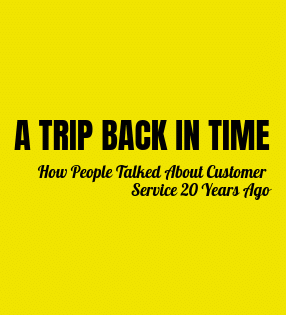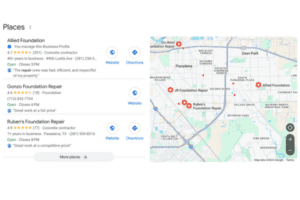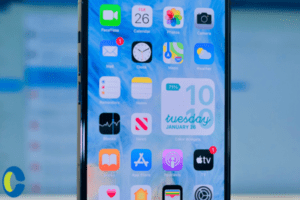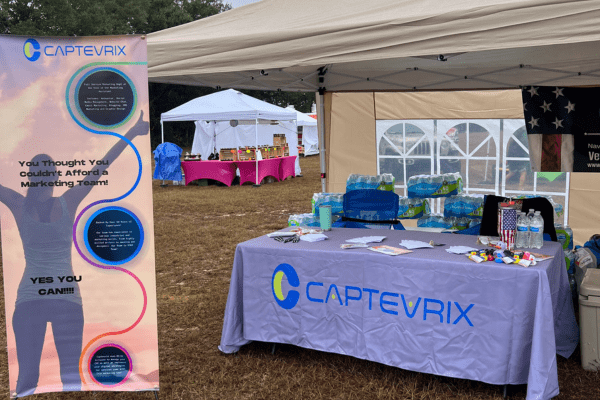So in a world that wasn’t wholly connected online yet and where all the information about a company and their customers’ experiences weren’t at the tips of a potential customer’s fingers (yeah, no smartphones either) how did people talk about customer service then?
Let’s jump inside our online time machine and take a look.
Oh, 1998.
The year of boy bands, Britney Spears and the Spice Girls.
The year of Titanic and Leonardo DiCaprio, Godzilla, Saving Private Ryan, Armageddon and Steven Tyler’s screaming about not missing a thing.
The year of political sex scandals, the unveiling of the first iMac from Apple, and the introduction of Harry Potter to the world.
While many of the things we know and are familiar with came to be that year, there were a lot of things different about the world back then.
The average income for a household in 1998 was $38,100 – you could fill your car for $1.15 a gallon, and a stamp cost all of 32 cents. Movies were rented at the video store and odds were if you were a kid, you were blowing into the cartridge of your favorite video game and praying it worked without erasing your game in the process. Recess was for trading Pokemon cards, and you were trying hard not to kill your Tamagotchi.
Computers were operating on Windows 98 and came with Internet Explorer, Google was only just founded, and Amazon merely sold books. Social media as we know it today with Twitter, Facebook, Instagram, and Yelp was nothing but a long distance pipe dream that would take another few years to begin becoming a reality.
Consumer to Consumer
In the case of the customer, the way customer service was primarily talked about hasn’t changed very much. Word of mouth would help build a brand’s business or cause a potential customer to turn away due to an experience someone they knew had and informed them of. One bad customer service experience and that person would be on the phone telling their friend what had happened who would, in turn, tell their friends and so on.
One incident could quickly turn away customers the brand already had or could have acquired if the experience had been positive. A good customer service experience could have the same effect; that customer goes home and calls up their friend to tell them about how fabulous the service was so that the friend tells theirs and goes to check out the company on their own.
For both good and bad experiences to be shared in a massive way such as they are today, the closest they could come would be AOL Instant Messenger chat rooms or on self-created Geocities websites. Through both of these, a customer could share their experience with a brand instantly to whoever was in the chat room or whoever happened to stumble upon their Geocities site. With only 41% of American adults online during 1998, the online feedback about customer service experiences would hardly be able to have the same impact it does today.
Consumer to Company
The way the customer communicates with a company has vastly changed over the last twenty years. In today’s consumer society, companies can be reached through social media, email, live chat, and in some cases, messenger apps – and the customer service department is typically available 24/7.
Back then, it wasn’t as easy to get in contact with a company as it has become today. The primary ways that they were able to communicate with the company were through fax, calls, voicemails, and eventually, emails as the internet became more widespread. To find out information about a company’s product, the only information the consumer could be provided was the company created information. The type of reviews and information that is available to consumers today about nearly any product they’re considering investing in was nowhere near as readily available as it is today.
If a consumer had a good or bad experience and wanted to speak to someone about it, they would have to call in and wait to talk to a representative during business hours. If there had been a problem that needed resolving, they would have to wait and potentially speak to multiple people within the same customer service department and repeat themselves over and over again to get the help they required. Or they would come in contact with an automated message that would attempt to help them.
The personalized service that many customers have gotten used to receiving and expect to receive was harder to come by back then. And for those that might have liked to try to solve the issue for themselves, a frequently asked questions page wasn’t something readily available online for every company.
Bringing It Back to 2018
The last twenty years have brought about a lot of change in the way customer service is talked about amongst customers and companies. With the changes, companies have grown to put customer service as their highest priority to maintain customer loyalty and increase their consumer base. The better and more personalized the service, the happier the customer is and the more good word of mouth and business the company receives.
Along with changes to how the conversations are conducted, the way companies find out about the conversation has changed as well through the rise of marketing automation technology that allows for you to collect customer data through emails, website visits, app usage, and on social media. This allows you to see where you can tailor your service towards your customers to give them a more personalized experience.
Also in today’s society, a company can use social listening to monitor the digital conversations being had about their brand and find out what is being said online. Website heat maps have also made it possible for you to see where exactly the customer is spending their time when they’re looking through your website. From the information gathered in the heat map, it is easy to see what customers are looking for and wanting to know from the company.
If you provide YouTube videos for your customers, you can use their analytics to see how long a video has been watched before the customer clicked away, how often your videos have been watched after a customer saw the thumbnail image, and how often your videos get recommended.
Ultimately, with the changes that have been made in the last twenty years, both customers and companies benefit positively to prepare for a better customer service experience.















